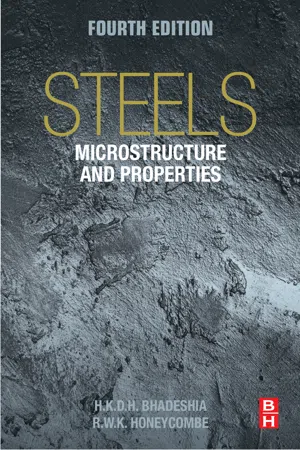
Steels: Microstructure and Properties
- 488 pages
- English
- ePUB (mobile friendly)
- Available on iOS & Android
Steels: Microstructure and Properties
About this book
Steels: Structure and Properties, Fourth Edition is an essential text and reference, providing indispensable foundational content for researchers, metallurgists, and engineers in industry and academia. The book provides inspiring content for undergraduates, yet has a depth that makes it useful to researchers.Steels represent the most used metallic material, possessing a wide range of structures and properties. By examining the properties of steels in conjunction with structure, this book provides a valuable description of the development and behavior of these materials—the very foundation of their widespread use.The new edition has been thoroughly updated, with expanded content and improved organization, yet it retains its clear writing style, extensive bibliographies, and real-life examples.- Contains a new chapter on nanostructured steels, with new content integrated into an existing chapter to describe the physical metallurgy of coatings, surface treatments, and multivariate high-performance steels- Includes derivations with important equations so that students from a broad range of subjects can appreciate the issues without being bogged down in mathematics- Presents new micrographs and figures that reflect the resolution and capabilities of modern instruments
Frequently asked questions
- Essential is ideal for learners and professionals who enjoy exploring a wide range of subjects. Access the Essential Library with 800,000+ trusted titles and best-sellers across business, personal growth, and the humanities. Includes unlimited reading time and Standard Read Aloud voice.
- Complete: Perfect for advanced learners and researchers needing full, unrestricted access. Unlock 1.4M+ books across hundreds of subjects, including academic and specialized titles. The Complete Plan also includes advanced features like Premium Read Aloud and Research Assistant.
Please note we cannot support devices running on iOS 13 and Android 7 or earlier. Learn more about using the app.
Information
Iron and Its Interstitial Solutions
Abstract
Keywords
1.1 Introduction
Table of contents
- Cover image
- Title page
- Table of Contents
- Copyright
- Preface to the First Edition
- Preface to the Second Edition
- Preface to the Third Edition
- Preface to the Fourth Edition
- Acknowledgments
- Acronyms
- Nomenclature
- Chapter 1: Iron and Its Interstitial Solutions
- Chapter 2: Strengthening of Iron and Its Alloys
- Chapter 3: Iron-Carbon Equilibrium and Plain Carbon Steels
- Chapter 4: Solutes that Substitute for Iron
- Chapter 5: Formation of Martensite
- Chapter 6: Bainite
- Chapter 7: Acicular Ferrite
- Chapter 8: Heat Treatment of Steels: Hardenability
- Chapter 9: Tempering of Martensite
- Chapter 10: Thermomechanical Treatment of Steels
- Chapter 11: The Embrittlement and Fracture of Steels
- Chapter 12: Stainless Steel
- Chapter 13: Weld Microstructures
- Chapter 14: Nanostructured Steels
- Chapter 15: Modelling of Structure and Properties
- Subject index